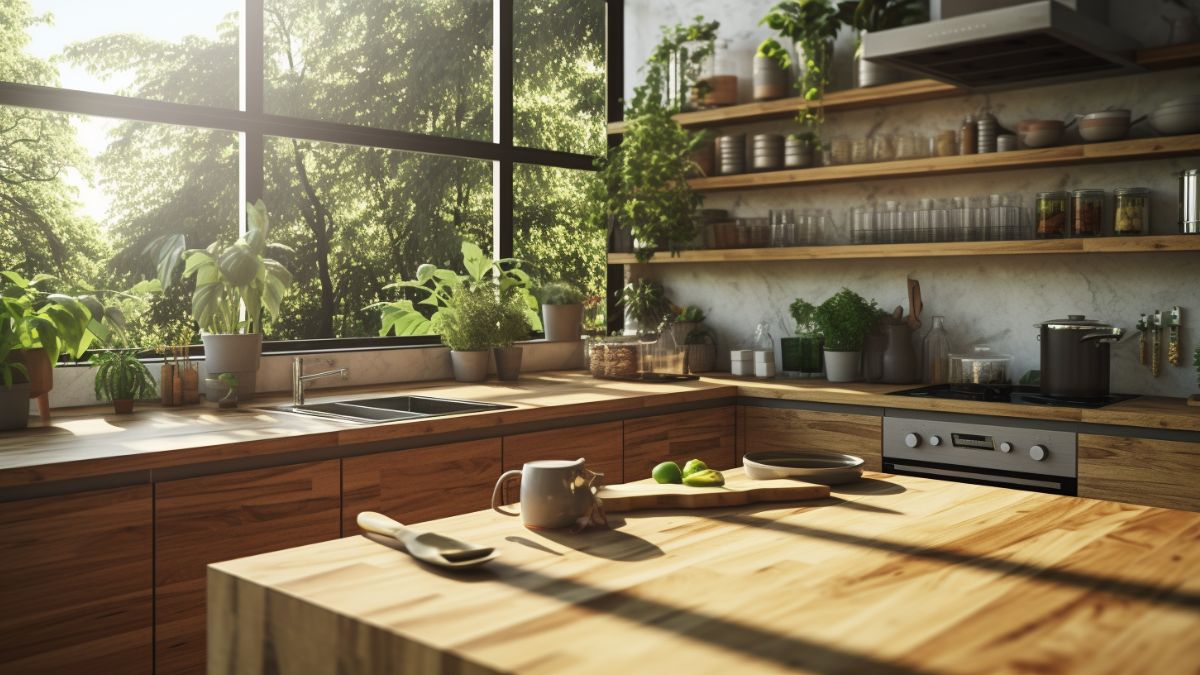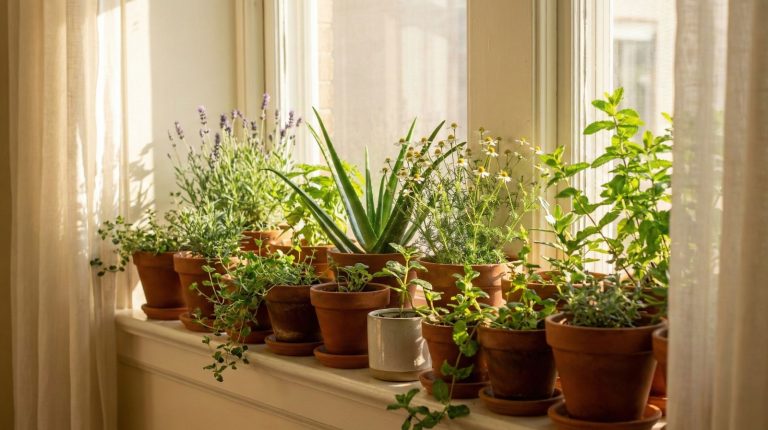Welcome to the kitchen of your dreams, where sustainability meets style! Get ready to embark on a journey to create an eco-friendly kitchen that not only looks fabulous but also helps to save the planet. In this ultimate guide, we will show you how to design a kitchen that not only suits your taste but also aligns with your values.
Think of your kitchen as a blank canvas, waiting for you to paint it with sustainable materials, energy-efficient appliances, and water-saving fixtures. It’s time to unleash your creativity and transform your kitchen into a green sanctuary.
But don’t worry, we won’t leave you hanging. We’ve got all the tips, tricks, and practical advice you need to make your sustainable dream kitchen a reality. From choosing the right materials to maximizing energy and water efficiency, we’ve got you covered.
So, join us on this exciting journey and let’s create an eco-friendly kitchen that will not only make you proud but will also make Mother Earth smile. Let’s get cooking, sustainably!
Key Takeaways
- Sustainable kitchen design emphasizes creativity and personalization while reducing waste and carbon footprint.
- Incorporating second-hand and reclaimed materials, as well as sustainable materials, energy-efficient appliances, and water-saving fixtures, is crucial for an eco-friendly kitchen.
- Non-toxic finishes and sustainable hardware for cabinets should be used to promote a healthier indoor environment.
- Maximizing space, using heat-storage range cookers, and implementing space-saving solutions like built-in organizers and pull-out shelves are important for efficiency and minimizing ecological costs.
Eco-Friendly Kitchen Concept
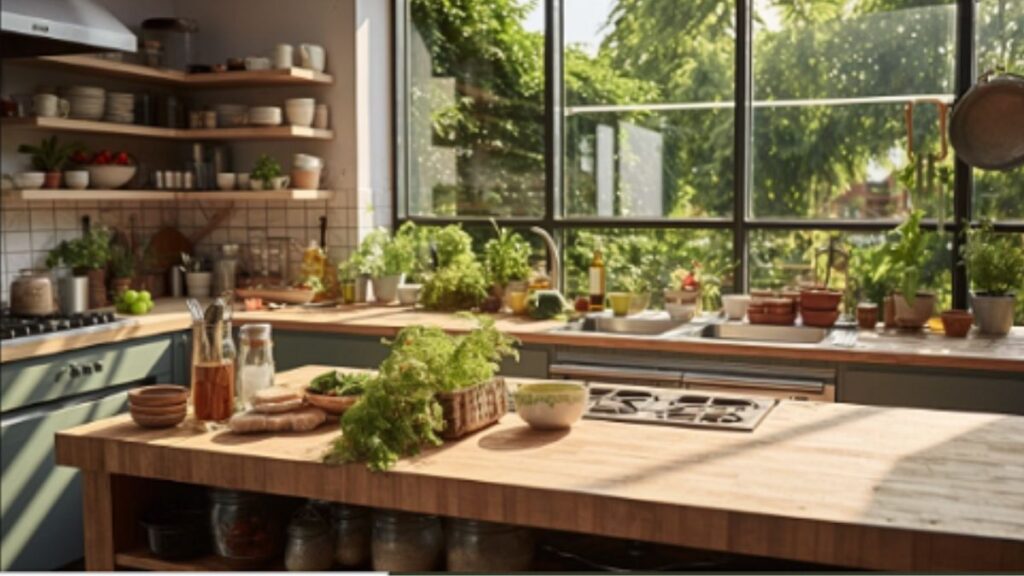
We will delve into the importance of sustainable kitchen design in remodeling projects and explore two fascinating approaches: utilizing reclaimed and natural materials or embracing modern and contemporary designs. We will introduce you to the concept of an eco-friendly kitchen and highlight the importance of incorporating sustainable design and green kitchen trends.
When it comes to designing your dream kitchen, why not consider making it eco-friendly? By opting for eco-friendly products and sustainable design, you not only contribute to a healthier environment but also create a beautiful and functional space for your culinary adventures. From energy-efficient appliances to eco-friendly materials, there are numerous ways to make your kitchen greener.
Sustainable design is not just a passing trend; it’s a conscious choice that can have a lasting impact. By choosing sustainable materials, you can reduce waste and the carbon footprint associated with your kitchen remodel. Whether it’s using reclaimed wood for your cabinets or opting for countertops made from recycled materials, there are plenty of options to choose from.
So, let’s dive into the world of eco-friendly kitchens and explore the various ways you can design a sustainable space that reflects your style and values. In the next section, we’ll discuss the importance of choosing sustainable materials and how they can contribute to a greener kitchen without compromising on style or functionality.
Choosing Sustainable Materials
When it comes to choosing sustainable materials for your kitchen, consider buying second-hand and reclaimed materials. Not only will this help reduce waste, but it can also add character and charm to your space. Additionally, opt for sustainable kitchen cabinets made from renewable resources or recycled materials. Finally, consider incorporating antiques and vintage furniture into your kitchen design, as they not only contribute to a unique aesthetic but also promote the reuse and repurposing of existing items.
Buying Second-Hand and Reclaimed Materials
Explore the benefits of buying second-hand and reclaimed materials for your eco-friendly kitchen, reducing your environmental impact while adding unique charm to your sustainable dream space. By diverting cabinetry and other kitchen items from landfills, you can contribute to a greener planet while also saving money.
When searching for second-hand kitchen items, keep in mind that there are many options available. You can find pre-loved cabinets, countertops, appliances, and more. Refurbishing these items not only reduces waste but also gives you the opportunity to customize them to your liking. You can paint cabinets in your favorite color or refinish countertops to match your desired aesthetic.
Buying second-hand and reclaimed materials has several advantages. Firstly, it is a cost-effective option, as these items are often significantly cheaper than buying new. Secondly, it adds character and uniqueness to your kitchen, as each piece tells its own story. Lastly, it reduces the demand for new materials, lowering the carbon footprint associated with manufacturing and transportation.
However, there are a few cons to consider. Second-hand materials may require more effort to clean, repair, or refinish. Additionally, finding specific sizes or styles might be more challenging when relying on second-hand options. Lastly, you may need to be patient and dedicate time to finding the right pieces for your kitchen.
Sustainable Kitchen Cabinets
To create a truly authentic and soulful kitchen, imagine the warmth and beauty that sustainable cabinets can bring to your space. By using upcycled materials for your cabinets, you not only reduce waste but also add a unique charm that can’t be replicated.
Look for reclaimed wood or FSC-certified plywood options, which are durable and sustainable. When it comes to hardware, opt for sustainable choices like recycled metal handles or knobs. These small details can make a big difference in reducing your carbon footprint.
Additionally, choose non-toxic finishes for your cabinets, ensuring a healthier environment for you and your family. With sustainable cabinets, you can have a kitchen that not only looks beautiful but also contributes to a greener world.
Now, let’s move on to incorporating antiques and vintage furniture seamlessly into your kitchen design.
Incorporating Antiques and Vintage Furniture
Immerse yourself in a world of timeless elegance and environmental consciousness as you seamlessly integrate antiques and vintage furniture into your kitchen design. By incorporating these unique pieces, you not only add character and charm to your space, but you also contribute to reducing waste and environmental pressure.
Antiques and vintage furniture offer a multitude of benefits when it comes to sustainable kitchen design. Firstly, they’re often made from high-quality materials that have stood the test of time, ensuring durability and longevity. Secondly, by repurposing and reusing these items, you prevent them from ending up in landfills, reducing your carbon footprint. Lastly, vintage furniture can add a touch of nostalgia and personality to your kitchen, creating a warm and inviting atmosphere.
Energy and Water Efficiency
When designing your sustainable dream kitchen, it’s important to consider the energy and water efficiency of the materials and appliances you choose.
Freestanding kitchen designs offer flexibility and allow for easy rearrangement, while reclaimed flooring adds a unique and eco-friendly touch.
Opting for eco-friendly paint and lighting not only reduces your carbon footprint but also creates a healthier indoor environment.
Water-saving appliances and window treatments can help conserve water and energy, making your kitchen more sustainable.
Related Article: Eco-Friendly Kitchen Products – Revolutionary Kitchen for A More Sustainable Lifestyle.
Freestanding Kitchen Designs
With their flexibility and adaptability, freestanding kitchen designs allow for easy changes and additions without the need to rip out the entire kitchen. Did you know that 75% of homeowners who choose freestanding kitchen designs report being happier with their ability to personalize and reconfigure their kitchen space?
This is not surprising considering the numerous benefits that come with freestanding kitchen designs. For instance, sustainable kitchen islands can be easily moved around to accommodate different layouts and design preferences. Eco-friendly kitchen countertops can also be swapped out or upgraded without disrupting the entire kitchen. This level of flexibility not only ensures a sustainable approach to kitchen design but also allows for creativity and personalization.
And speaking of sustainability, let’s now move on to the next section about reclaimed flooring.
Reclaimed Flooring
Transform your space with the timeless beauty of reclaimed flooring, breathing new life into your home with its rich history and character. Not only does reclaimed flooring provide a unique and rustic aesthetic, but it also offers a sustainable flooring option for your kitchen design.
Here are four reasons why using reclaimed materials in your kitchen is beneficial:
- Eco-Friendly: By using reclaimed flooring, you’re reducing the demand for new resources and minimizing waste. It’s a small step towards a greener future.
- Durability: Reclaimed wood has stood the test of time, making it incredibly durable and long-lasting. You can count on it to withstand the demands of a busy kitchen.
- Unique Touch: Each piece of reclaimed flooring has its own story, adding a touch of history and character to your kitchen. It’s like having a piece of art under your feet.
- Versatility: Reclaimed flooring comes in various styles, colors, and finishes, allowing you to create a customized look that perfectly suits your kitchen’s design.
So, now that you’ve transformed your space with reclaimed flooring, let’s move on to the next step: eco-friendly paint and lighting.
Eco-Friendly Paint and Lighting
You’ve made a great choice with reclaimed flooring for your eco-friendly kitchen! Now, let’s move on to the next important aspect: eco-friendly paint and lighting.
When it comes to lighting, energy efficiency is key. LED lighting is not only energy-efficient but also provides excellent light distribution, ensuring that your sustainable dream kitchen is well-lit and inviting.
As for paint, traditional options often contain microplastics that harm the environment. Instead, opt for non-toxic paint alternatives that are plastic-free and eco-friendly. These paints not only reduce your carbon footprint but also create a healthier indoor environment for you and your family.
Additionally, consider natural lighting solutions such as skylights or large windows to maximize the use of natural light during the day.
Now, let’s dive into the next section about water-saving appliances and window treatments.
Water-Saving Appliances and Window Treatments
To create a visually stunning and sustainable kitchen space, consider incorporating water-saving appliances and bamboo window treatments that add a touch of warmth. Water-saving appliances, such as eco-friendly faucets and boiling water taps, not only help conserve water but also reduce energy usage. Traditional kettles can be replaced by boiling water taps, saving both water and energy. These taps provide instant hot water, eliminating the need to wait for the kettle to boil.
In addition to water-saving appliances, sustainable window treatments made from eco-friendly bamboo can mimic the warmth of wood while reducing the need for artificial lighting. Bamboo is a renewable resource that grows quickly, making it an environmentally friendly choice for window treatments.
By incorporating water-saving appliances and sustainable window treatments, you can create a beautiful and eco-friendly kitchen. Now, let’s dive into practical tips for an eco-friendly kitchen remodel.
Practical Tips for an Eco-Friendly Kitchen Remodel
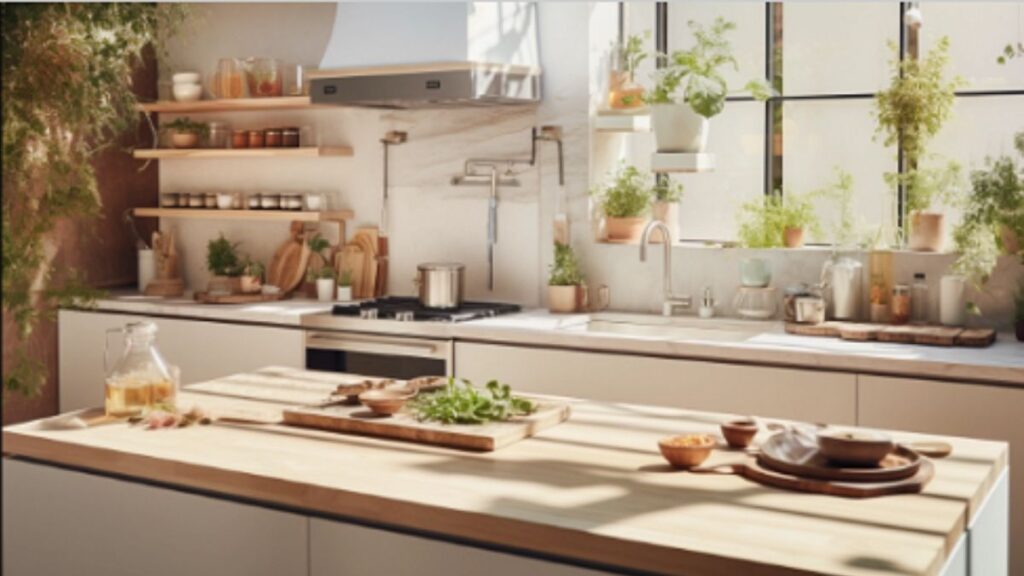
If you’re looking to remodel your kitchen in an eco-friendly way, there are a few key points to consider.
- One option is to update your cabinet doors with sustainable materials like bamboo or reclaimed wood.
- Another idea is to invest in a heat-storage range cooker, which uses excess heat to warm your kitchen and reduce energy consumption.
- Lastly, maximizing space and minimizing ecological costs can be achieved by incorporating efficient storage solutions and choosing appliances with high energy efficiency ratings.
By implementing these practical tips, you can create a sustainable and stylish kitchen that’s kind to the environment.
Updating Cabinet Doors
Transform your kitchen into an eco-friendly haven by updating your cabinet doors with cost-effective, neutral cabinetry and classic Shaker designs that offer versatility and easy updates.
Upcycling cabinets is a great way to reduce waste and give your kitchen a fresh new look. Look for sustainable hardware options, such as handles and knobs made from recycled materials.
When it comes to paint, choose eco-friendly options that are free from harmful chemicals and low in VOCs (volatile organic compounds). These paints not only protect your health but also the environment. Consider using non-toxic milk paint or natural oils for a more sustainable choice.
By embracing these eco-friendly practices, you’ll not only create a beautiful and functional kitchen but also contribute to a greener planet.
Now, let’s move on to the next section and explore the benefits of heat-storage range cookers.
Heat-Storage Range Cookers
Embrace the efficiency and longevity of heat-storage range cookers to elevate your kitchen experience.
Heat-storage range cookers are a game-changer when it comes to sustainable kitchen design. Equipped with heat storage technology, these appliances retain heat and distribute it evenly, reducing the need for constant energy consumption. By utilizing renewable energy sources such as solar or wind power, heat-storage range cookers contribute to a greener and more eco-friendly kitchen.
Not only are they energy efficient, but they also offer a range of cooking options, from baking to slow cooking, all in one appliance. With their sleek and modern design, heat-storage range cookers bring style and functionality to your kitchen.
So, why settle for multiple appliances when you can invest in a long-lasting, efficient option? Make your kitchen eco-friendly with heat-storage range cookers and get ready to maximize space and minimize ecological costs in the next section.
Maximizing Space and Minimizing Ecological Costs
To truly create a kitchen that harmonizes with nature, envision a space that effortlessly blends efficiency and sustainability, where every element symbolizes a commitment to maximizing space and minimizing ecological costs.
Space saving solutions are key in designing an eco-friendly kitchen. Consider installing cabinets with built-in organizers and pull-out shelves to optimize storage space. Choose sustainable countertop options, such as recycled glass or bamboo, which not only reduce ecological costs but also add a unique touch to your kitchen design.
When it comes to appliances, opt for eco-friendly options that are energy-efficient and made from recycled materials. Look for appliances with the Energy Star label, as they consume less energy and help reduce your carbon footprint.
By incorporating these space saving solutions, sustainable countertop options, and eco-friendly kitchen appliances, you can create a kitchen that not only looks great but also helps protect the planet for future generations.
Now, let’s move on to the essential checklist for your eco-friendly kitchen remodel.
Essential Checklist for Eco-Friendly Kitchen Remodel
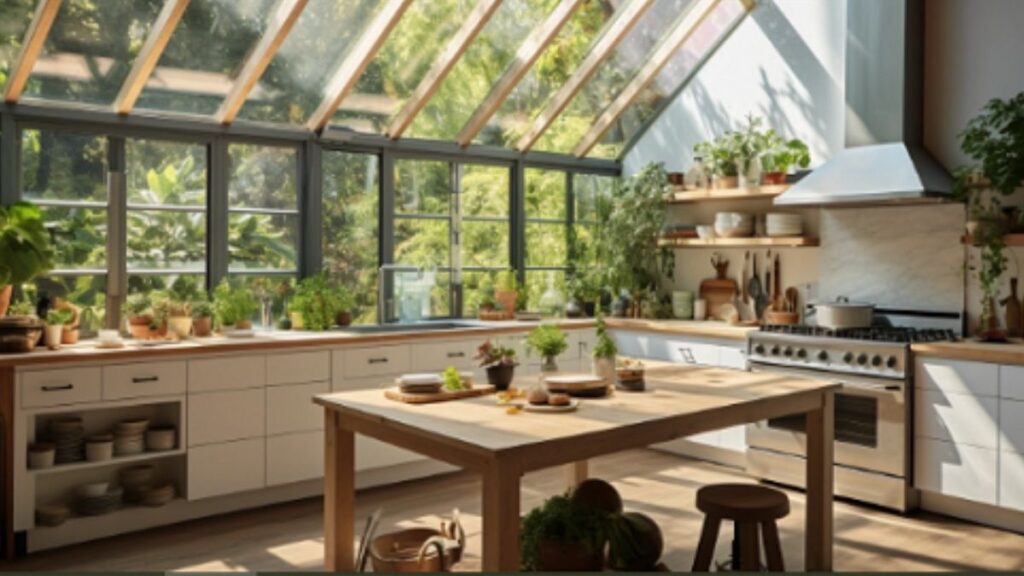
Creating an eco-friendly kitchen is easier than you think with this essential checklist for a sustainable kitchen remodel. By focusing on water efficiency, energy efficiency, and sustainably-sourced materials, you can transform your kitchen into an environmentally-friendly space.
- Start by finding an eco-expert contractor who can guide you through the process and ensure better results.
- Choose eco-friendly materials for countertops, flooring, and backsplash, such as FSC-certified wood or recycled tiles.
- Build non-toxic, sustainable cabinets using formaldehyde-free woods, solid wood, or bamboo.
- Select water-efficient fixtures like low-flow faucets and energy-efficient lighting like LEDs and natural lighting.
- Invest in energy-efficient appliances, preferably all-electric, to reduce power plant emissions.
- Use VOC-free paints, finishes, and coatings to avoid harmful chemicals.
By following this checklist, you can create a beautiful and sustainably-sourced kitchen that will benefit both the environment and your health.
Frequently Asked Questions
What are some eco-friendly alternatives to traditional kitchen appliances?
Looking to make your kitchen eco-friendly? Opt for energy-efficient lighting that saves energy and money. Choose appliances with sustainable material certifications to reduce your carbon footprint. It’s a win-win for the planet and your wallet!
How can I incorporate natural lighting into my kitchen design to reduce energy usage?
Why rely on artificial lighting when you can bask in the warm glow of the sun? Maximize sunlight in your kitchen to reduce energy usage by incorporating large windows, skylights, and sun tunnels. Natural lighting benefits and energy efficient lighting solutions all in one!
Are there any specific certifications or labels I should look for when selecting sustainable materials for my kitchen?
When selecting sustainable materials for your kitchen, look for certifications and labels such as LEED, FSC, and Greenguard. These ensure that the materials meet strict environmental and health standards, giving you peace of mind and a stylish, eco-friendly kitchen.
Can you provide some tips on how to properly dispose of kitchen waste in an eco-friendly manner?
Proper disposal of kitchen waste is crucial for an eco-friendly kitchen. Embrace the art of composting, where food scraps turn into nutrient-rich soil. And don’t forget to recycle packaging materials, because saving the planet can be hilarious!
What are some innovative ways to conserve water in the kitchen, besides using low-flow faucets and water-saving appliances?
Save water in the kitchen with innovative techniques. Try greywater recycling, where you reuse water from sinks and showers for irrigation. Drip irrigation systems are also great for conserving water in your garden. Be water-wise and eco-friendly!
Conclusion
By choosing sustainable materials and incorporating energy and water-efficient appliances, you’ve taken a significant step towards reducing your carbon footprint. Your commitment to creating a sustainable kitchen is commendable and will inspire others to follow suit.
Remember, Rome wasn’t built in a day, so don’t be discouraged if the process was challenging at times. As the saying goes, “Slow and steady wins the race,” and your efforts will surely pay off in the long run. Keep up the good work and enjoy your new environmentally-conscious kitchen!

